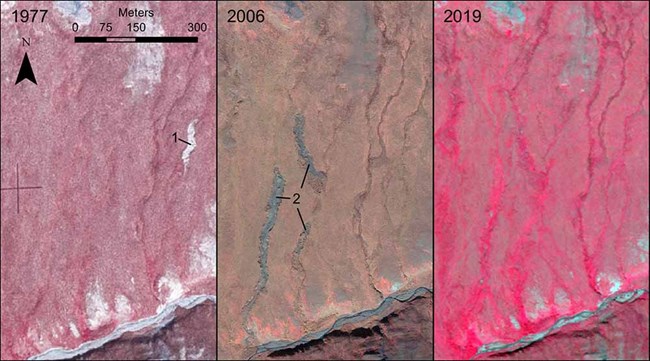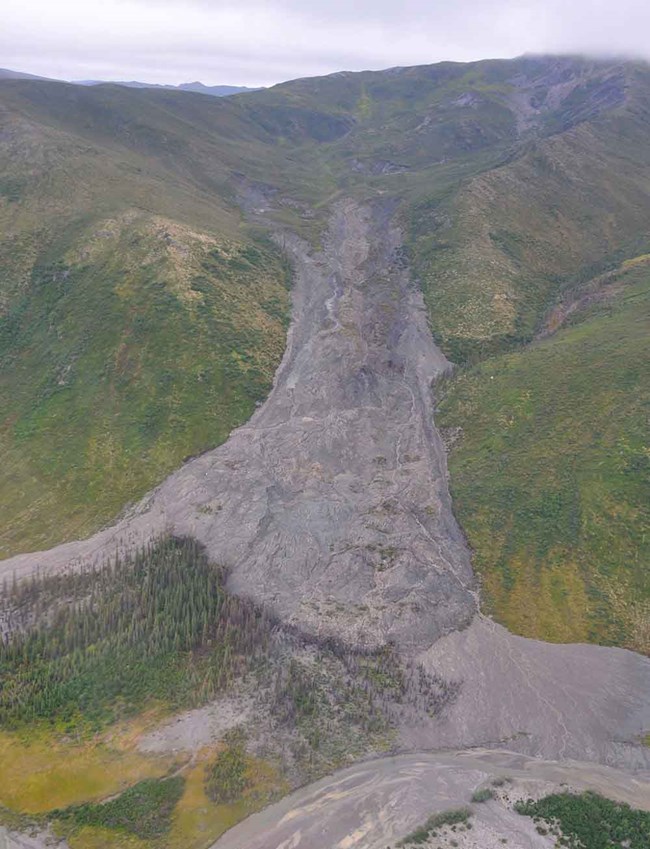Last updated: January 27, 2021
Article
Monitoring permafrost thaw erosion features

In 1977, there was one recent ALD (1). In 2006 the 1977 ALD was completely re-vegetated and three new ALD had recently formed (2). In 2019 all previous ALD had revegetated. This location is near longitude -157.904°, latitude 68.251°.
The National Park Service Arctic Inventory & Monitoring Network uses high-resolution satellite images and historical color-infrared aerial photographs to monitor the abundance of landslides resulting from permafrost thaw. Active-layer detachments (ALD) and retrogressive thaw slumps (RTS) are small landslides that occur as a result of thaw in permafrost regions. They expose bare soil that can be readily mapped on color-infrared imagery. We mapped the extent of bare soil in thaw-related slope failures in four study areas with continuous permafrost, on aerial photographs from c. 1980, satellite images from 2006-2009, and satellite images from 2018-2019. RTS and ALD were especially abundant in the 2006-2009 sample, probably as a result of exceptionally warm summers in the mid-2000 decade.

The lobe has moved about 400 m downhill and the affected area is now about 900 m long. This location is near longitude -151.896°, latitude 67.748°.
Surprisingly enough, in all four study areas, the count of ALD and RTS and the area of bare soil they exposed, was lower in the most recent sampling episode (2018-2019) than in the previous ones. This occurred in spite of record-warm conditions that prevailed in the study area in 2014-2019. These results show that slopes can be stable under warming conditions, if conditions remain cold enough to maintain permafrost below the active layer.
One study area had frozen debris lobes (FDLs) in addition to ALD and RTS. These are lobe-shaped masses of frozen material that usually creep downslope at a rate of less than 10 m/year, while remaining mostly vegetated. Several of our FDL became unstable due to deep thaw of permafrost and began to move more rapidly downhill at rates of about 30 m/year. The area of bare ground exposed by destabilization and rapid movement of FDLs was greatest in the 2018-2019 sampling episode. The FDLs are in the part of the study area with the warmest mean annual temperatures—high enough that recent warming led to thaw and destabilization of deeper permafrost.
Permafrost thaw‐related slope failures in Alaska’s Arctic National Parks, c. 1980–2019
Abstract
Active‐layer detachments (ALD) and retrogressive thaw slumps (RTS) are landslides that occur as a result of thaw in permafrost regions. I mapped the extent of bare soil exposed in these thaw‐related slope failures in four study areas with continuous permafrost in Alaska’s Arctic National Parks, on mosaics of aerial photographs from 1977–1985 (sampling episode 1), satellite images from 2006–2009 (sampling episode 2), and satellite images from 2018–2019 (sampling episode 3). In all four study areas the count of ALD and RTS, and the area of bare soil they exposed, was greater during the first or second sampling episode than the third sampling episode, in spite of record high mean annual temperatures in 2014–2019. One study area had frozen debris lobes (FDL) in addition to ALD and RTS. In that study area the bare ground exposed by destabilization and rapid movement of FDL was greatest in the third sampling episode, probably as a result of deep thaw and talik formation. The destabilization of FDL in episode 3 was probably a long‐term consequence of warming and permafrost loss, while the observed pulses of ALD and RTS in episodes 1 and 2 were closely tied to short‐term deep thaw events in areas where the underlying permafrost remained stable.
Swanson, D. K. 2021. Permafrost thaw-related slope failures in Alaska’s Arctic national parks, c. 1980-2019. Permafrost and Periglacial Processes doi:10.1002/ppp.2098.
